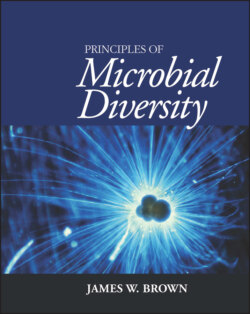Читать книгу Principles of Microbial Diversity - James W. Brown - Страница 68
Example analysis
ОглавлениеIn about 1990, an organism designated ES-2 was isolated from a deep-sea hydrothermal vent sample. ES-2 grows heterotrophically at 65°C. A lipid analysis of the isolate was unusual, showing that it contained a number of apparently branched lipids as well as fatty acids. Electron microscopy and standard microbiological tests were not helpful in identifying the organism.
Phylogenetic analysis of the organism was performed essentially as above. DNA was isolated from cells, and the SSU rRNA was amplified by PCR using primers near both the 5′ and 3′ ends of the gene. The amplified DNA was cloned and sequenced (Fig. 4.7), and the secondary structure of the encoded RNA was determined for use in the alignment process (Fig. 4.8).
Figure 4.7 Sequence of the ES-2 SSU rRNA, in GenBank format. doi:10.1128/9781555818517.ch4.f4.7
With the sequence in hand, the next step in the process was to align the sequence with the SSU rRNA database. This was originally done by hand in a local database, but these days it can be done automatically at the Ribosomal Database Project (RDP), using an algorithm called “infeRNAl” (from INFER RNA ALignment). After this, the next step was to calculate phylogenetic trees; the RDP uses a weighted neighbor-joining method. First, a “representative” tree was generated using representative sequences from each major phylogenetic group of bacteria to see which group ES-2 seems to belong to (Fig. 4.9).
Figure 4.8 Secondary structure of the ES-2 SSU rRNA sequence. This is a hand-drawn image, because that is the way these structures are usually sorted out. doi:10.1128/9781555818517.ch4.f4.8
Figure 4.9 Phylum-scale tree including ES-2, generated using the RDP II website. doi:10.1128/9781555818517.ch4.f4.9
ES-2 is clearly most closely related to the representative of the phylum Firmicutes (represented by Bacillus mycoides). So, the next step was to generate another tree by using representative sequences from the Firmicutes (Fig. 4.10). At the time this analysis was performed, only a few such sequences were available. Now there are thousands of Firmicute sequences in the database.
This tree shows that ES-2 is a member of the Clostridium/Eubacterium group of the Firmicutes. So a final tree with representatives of this group, and some especially close relatives identified using BLAST was generated (Fig. 4.11).
Figure 4.10 Tree of representative Firmicutes, including ES-2, generated using the RDP II website. doi:10.1128/9781555818517.ch4.f4.10
Figure 4.11 Fine-scale phylogenetic tree of ES-2, generated using the RDP II website. doi:10.1128/9781555818517.ch4.f4.11
